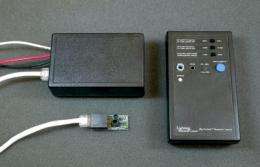DaySwitch Field Test Demonstrates Simple Daylight Harvesting Technology to Save Energy

(PhysOrg.com) -- Lighting accounts for about one-quarter of the electricity consumed by the commercial sector in the United States and energy-efficient lamps, ballasts, and lighting controls represent significant opportunities to save energy, money and reduce CO2 emissions associated with fossil fuel electric generation.
Lighting control manufacturers have developed dimming systems designed to dim/turn off lamps and reduce energy use from electric lighting when daylight is available. However, according to Rensselaer Polytechnic Institute’s Lighting Research Center (LRC), these daylighting controls have not gained widespread acceptance in the market due to high initial cost, difficulties installing and programming the devices, and consumers’ lack of awareness of the technology.
The LRC has been working on a daylight-switching device called the DaySwitch, designed for existing lighting fixtures and featuring simple setup and commissioning. With $198,745 co-funding from the New York State Energy Research and Development Authority (NYSERDA), the LRC research team collaborated with manufacturing partners to build DaySwitch prototypes and recently field tested the devices in a wide range of locations across the Rensselaer campus in Troy, N.Y., through a $398,248 project at the LRC which demonstrates and evaluates lighting technologies and applications (DELTA). The demonstration results are summarized and published in Field Test DELTA: Daylight-Harvesting Switch.
NYSERDA President and CEO, Francis J. Murray, Jr. said: “This easy retro-fit technology offers a significant opportunity for savings and efficiency, by integrating daylighting controls with the existing building lighting systems. NYSERDA is proud to be involved with the development of this technology and pleased that several manufacturers, including New York companies, are in negotiations to commercialize this technology in a way that will help build New York’s clean energy economy.”
To test the DaySwitch in diverse, real-world conditions (public spaces, open-plan offices, and private offices), calculate energy savings, assess occupant acceptance, and gather installation feedback from electricians, DaySwitch devices were installed in 72 locations across campus, each with varying degrees of daylight access from windows or skylights. The primary market for the DaySwitch is commercial retrofit, although it can also be incorporated into new luminaires.
How the DaySwitch works
There are three main components to the DaySwitch: the sensor module, the control module, and a remote commissioning device. A built-in microcontroller automatically calibrates the DaySwitch, allowing for easy setup, according to LRC researchers. The DaySwitch senses when sufficient daylight is available to take the place of the electric light in the space and turns off the light fixture. When daylight decreases below the set point, the device switches the electric light back on. To install the DaySwitch, the microcontroller is mounted inside the luminaire to switch the lamps on and off. The photosensor is connected to the micro-controller via wires and is mounted outside the luminaire to monitor daylight levels in the space.
“The field test results support the use of the DaySwitch as an alternative to the existing lighting dimming control technologies that are expensive and difficult to commission,” said Jennifer Brons, LRC research scientist and DELTA Program manager. “The feedback we gathered has enabled us to identify applications where the DaySwitch will be most effective in saving energy associated with turning off unnecessary electric lighting.”
Study Findings
• The DaySwitch provided the most energy savings in large open spaces with plentiful daylight, high luminaire wattages, and long hours of use.
• Commissioning was hassle-free, requiring only about 30 seconds per DaySwitch.
• The DaySwitch worked as intended by automatically switching off lights when sufficient daylight was available.
• Feedback from most occupants was generally neutral or positive. There were a few occupants of private offices who objected to automatic switching.
• Private offices showed little or no energy savings because of minimal daylight availability (blinds, window tinting, and obstructions), low luminaire wattages, short hours of occupancy, and manual operation of a wall switch. Some private offices on the campus were over-lighted, which reduced the ability to switch off the lights because the Dayswitch determines its switching threshold as a function of the measured electric light level.
For complete details, access the Field Test DELTA: Daylight-Harvesting Switch publication online at www.lrc.rpi.edu/programs/DELTA … HarvestingSwitch.pdf .
Provided by Rensselaer Polytechnic Institute
















